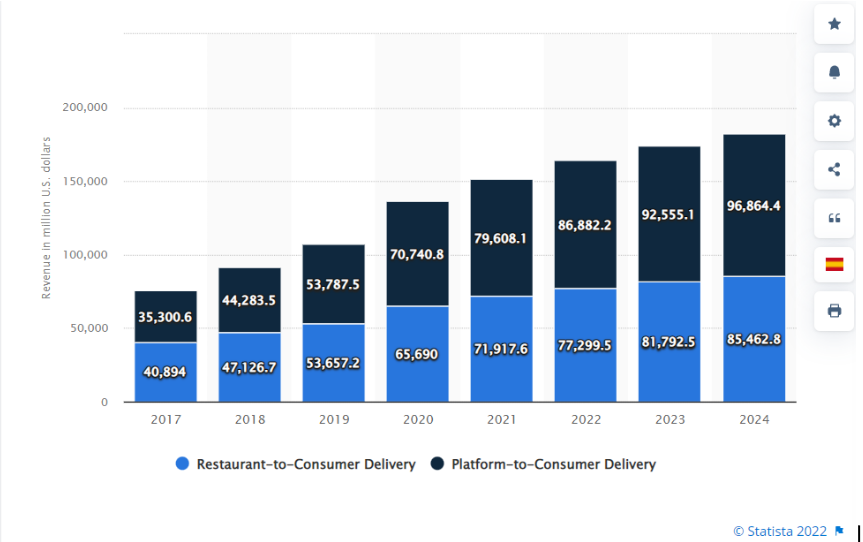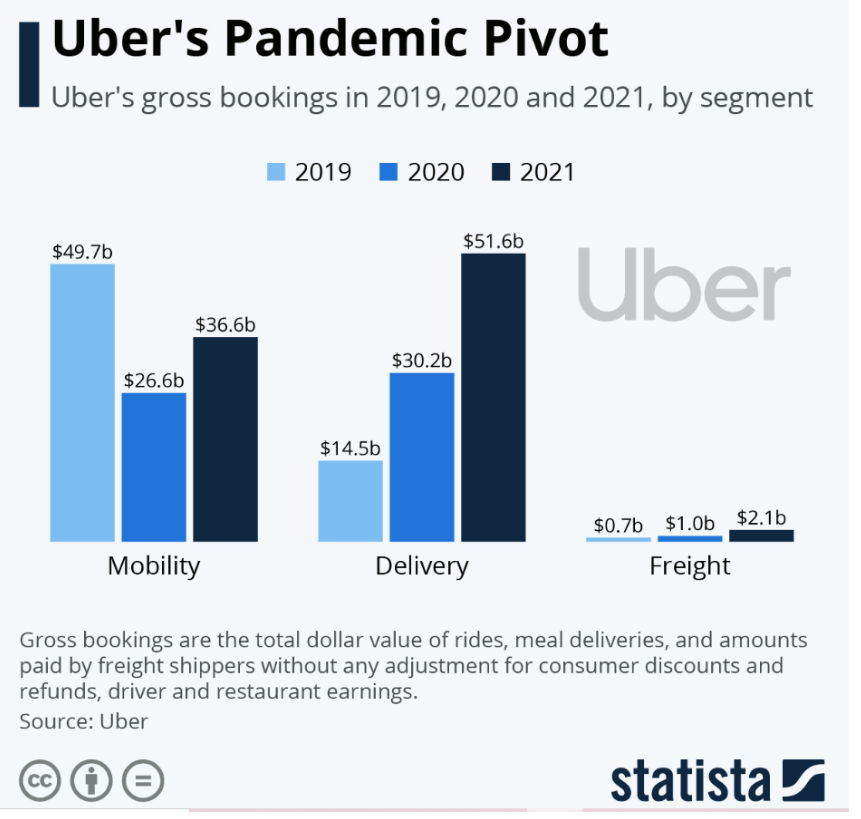People love food, and when they get the facility to savor their favorite meal in the comfort of their home, what’s better than that?
According to a report by Statista, the global revenue in the online food delivery sector has doubled since 2017. The revenue of online food delivery platforms in 2020 was 70,740 million US dollars, and it is expected to grow to 96,864.4 million US dollars by 2024.

Alone in the United States, 44% of consumers use food delivery services at least once a month.
The great potential in the food delivery apps has opened the gates of opportunities for the grocery delivery app development services. And here comes food delivery apps like Uber into the picture.
Do you also want to build a grocery delivery app like Uber Eats? Then you have landed on the right page.
But one thing, building an app like Uber Eats is not a piece of cake. It takes time, finances, expertise, and the use of state-of-the-art technologies, to name a few. Such apps come with different aspects like admin panels, users panels, panels for couriers, etc., and each aspect has its own complexity.
Let us move ahead and discuss each step of food delivery app development in detail.
Understanding Uber Eats and its Market Share
Every business visionary who wishes to invest in grocery delivery services like Uber Eats wants to know the secret of its success. Below are mentioned som e important figures that will help you understand the popularity of the food delivery platform.
- The gross booking of Uber Eats reaches 4.68 billion US dollars, which is 52% of the entire food delivery industry.
- The company has also witnessed a hike in GAAP revenue of 819 billion US dollars.
- Uber Eats is expected to cover 21% of the United States market share.
- In the United Kingdom, it is likely to cover 27% of the market share.
- In Europe and China, Uber Eats will likely cover around 20% of the market share.
- Alone in the United States, Uber Eats generated a revenue of 7 billion US dollars.
- United Kingdom, Australia, United Arab Emirates, and India have 2 million, 66 million, 300k, and 10 million downloads of Uber Eats, respectively.
The Secret of Success of Uber Eats During The Pandemic
Food Delivery apps have been pivotal during the pandemic. When everything was on lockdown, food delivery apps were the only way to savor our favorite food without stepping outside.
The surge in the demand helped UberEats cover 29% of the global food delivery market. The company has adopted some really worth considering strategies that have helped them stay relevant in the challenging times.

Key Strategy for Customer – The food delivery company has launched the covid-19 awareness campaign to promote contactless food delivery at the door of consumers. It introduced the Leave at Door policy.
Key Strategy for Restaurants – For all its registered restaurants, UberEats launched an Opt-in program, especially in US and Canada. Opt-in has enabled restaurant owners to encash payouts on a daily basis rather than a weekly basis, which is the company’s standard policy.
Key Strategy for Delivery Staff – The company has taken care of its delivery executives by offering them all necessary sanitization materials like masks, gloves, sanitisers, etc.
Key Strategy for the Healthcare Workers – The company indulged in philanthropic work during the pandemic by distributing free meals to more than 300,000 covid-19 healthcare workers and first-responders. This figure was alone from Canada and the US.
The Business Model of Uber Eats
Uber Eats works as both – a restaurant aggregator and a delivery agent – which makes it quite unique. The innovative approach has made UberEats cover 6000 cities across 45 countries across the globe, with 600,000 supported restaurants.
Let’s move ahead and understand the business model of Uber Eats that will come handy to you at the time of food delivery on-demand mobile app development cost & key features finalization.
Activities
- Build a relationship with retail stores
- Develop & manage tech-based infrastructure
- Manage customer orders and process delivery
- Hire delivery agents
- Streamline delivery system
Earning Source
- Merchant- commission
- Customer – delivery fees
- Ads sponsoring
- Featured ads
Resources
- Technology
- Freelance delivery provider
- Partnership with a local provider
Customer
- For a customer who doesn’t wish to go to restaurants
- For a client who likes to order food online
- An individual who wishes to have food at his/her doorstep
Merchant
- Restaurants that do not have on-demand food delivery service
- For the merchants who wish to be a partner of the Uber Eats ecosystem
Channels
- Digital marketing
- App Store
- Play Store
- Tablets
UberEats Partners
- Delivery suppliers
- Grocery stores
- Restaurants
- Retail stores
Expenditure Structure
- Permanent employees’ salary
- Delivery providers’ salary
- Tech set up and running cost
Customer Relationship
- Customer chat support
- Social media channels
- Ratings and reviews
- Promo codes
- User support
- Feedback portals
Delivery Provider
- Tips received by the delivery agent from customers
- Freelance works to buy some extra money
Revenue Generation
- Small order fee
- Standard delivery fees
- Fee for marketing and advertising from the partnered restaurants and eateries.
- Recurring revenue share from restaurant partners
Value Proposition
- Super fast food delivery
- Cutting-edge algorithm
- No minimum order concept
- Efficient resource use
- Existing customer base
- World wide presence
The Working Methodology of UberEats’ Business Model
We have understood the different aspects of the UberEats model. If you wish to develop on-demand food delivery apps similar to Uber Eats, it’s imperative for you to understand its methodology.
- UberEats connects three marketplace – restaurants, customers, and delivery agents.
- Restaurants register themselves on Uber Eats with the menu.
- Customers search for restaurants – location-wise, menu wise, etc.
- Delivery agents pick up food orders from restaurants and deliver them to the doorstep of the customers.
The Four Imperative Key Resources of Uber Eats
Restaurants – The main work of restaurants is to manage food orders and update the latest menu on the food delivery app. Restaurants have the right to update and manage their profile and different elements like the name of the restaurant, contact number, price of the items on the menu, and opening & closing hours.
Customers – Customers have the option to make a real-time food order and custom food order. Real-time food ordering enables food lovers to choose the food of their choice from the restaurant in their nearby areas.
Custom food ordering lets customers schedule their order in advance. Evident to its name, a customer can customize the delivery date, destination address, time of delivery, and other options.
Delivery Agents – These are the individual people who work for Uber Eats. They pick up orders from restaurants and deliver them to customers’ doorstep. Uber East has empowered them to accept and manage multiple orders as per their discretion.
How to Develop a Food Delivery App Like Uber Eats?
Here is the answer to the question –
Thorough Market Research – To build any app, the first and foremost step is to conduct thorough market research. What you should do in research?
- Check the competitors in the food delivery app segment.
- Research for the latest food industry trends.
- Identify a suitable location for online food delivery services.
- Analyze the crucial features you wish to include in your food delivery app.
- Identify your target prospects.
Finalize The Food Delivery Model
This step is crucial as it will put the foundation of your on-demand food delivery mobile application. Select a model that complements your business goals and the needs of the customers.
The first model is ordered only model and the second is the order & delivery model. Both these models include features like accepting orders and order management. They both have different logistic support.
Finalize the Crucial Features That Make Your Food Delivery App Like Uber Eats
Admin Panel Features
- Restaurant management
- Food delivery management
- Multiple language support
- Multi-store support
- Multiple payment gateway options
- Statistics and analytics
- Notifications
Restaurant Panel Features
- Management of orders
- Menu management
- Push notifications
- Easy tracking of payments
- Managing ratings and reviews
- Support and assistance
- Tracking of delivery
Customer Panel Features
- User Registrations
- Listing of Restaurants and eateries
- Order tracking
- Multiple payment gateway options
- Options for takeaway
- Discounts, promos, offers
- Advanced level search
- Reward points
- Reviews and ratings
Delivery Agent Panel Features
- Secure Login
- Accept order
- Reject order
- Order management as per location
- Push notification
- Real-time tracking
- Multiple deliveries
Work with the Latest Technology Stack
Application & Data
- jQuery
- Python
- Node.js
- React
- NGINX
- Java
- MySQL
- PostgreSQL
- MongoDB
- Redis
- Amazon EC2
- Kafka
- Swift
- Go
- Objective-C
- Backbone.js
- Cassandra
- Hadoop
- Apache Thrift
- Apache Spark
- RIBs
- AresDB
Utilities
- Google Analytics
- Elasticsearch
- PayPal
- Twilio SendGrid
- Twilio
- Mixpanel
- Optimizely
- TensorFlow
- Crazy Egg
- Heap
- Braintree
- HackerOne
- Ludwig
DevOps
-
- Grafana
- Terraform
- Sentry
- RequireJS
- Prometheus
- Puppet Labs
- Nagios
- Zookeeper
- Graphite
- Jaeger
- Brunch
- Uberalls
- M3
- Zap
- Kraken by Uber
- Makisu
- Peloton
Business Tools
- G Suite
- Asana
- Zendesk
- Mattermost
- OneLogin
- iDoneThis
- Delighted
APIs for Food Delivery App
- Foursquare API
- Uber Eats API
- Google Place API
- Freshchat API
- GrubHub API
- MapBox API
- Google Matix
- TomTom’s NavApp and MapLibrary APIs
- OneSignal API
- Waze Navigational API
Choose Your Mobile App Development Team
There are majorly two options available to build a food delivery app like Uber Eats. First is that you hire a mobile app development team, and second is you use a ready-made solution.
Mobile app development team members include – Android developer, iOS developer, Front-end developer, back-end developer, project manager, business analyst, UX/UI designer, QA analyst.
How Much Time it Requires to Build App Like Uber Eats
The development of customized food delivery apps like Uber Eats takes a substantial amount of time. The UX/UI process takes 60 hours. For the front and back end development, it will take around 400 hours.
The technical documentation may take approximately 400 hours. Whereas the MVP stage testing will require 80 hours for an app like Uber Eats. The final polishing and bug fixing will take around 40 hours. And after a total of 620 hours, your app will be in your hand.
How Much Does It Cost To Make a Food Delivery App Like Uber Eats?
The cost of customized food delivery app development like Uber Eats is generally affected by multiple factors. These factors are the technology used, features included, the complexity of features, the expertise of the developers, country, etc.
On average, if we have to give a ballpark figure, the cost of food delivery app development costs you around $6000 to $10,000. If there is a restaurant app you wish to make, in that case, the budget rises to 20,000 USD.
In different countries, the cost of development varies – India has $10 to $80 per hour. In European countries, development cost varies between $30 to $90 per hour, and in the United States, the development cost varies between $50 to $100 per hour.
Conclusion
Ever since the pandemic has hit our world, the ecosystem of food delivery mobile apps has seen a tremendous surge with respect to demand, sales, and market share.
It is the right time to invest in developing a grocery delivery app like Uber Eats. The food delivery industry is flourishing and the chances are you might leverage the million dollar industry effortlessly.
Develop on-demand food delivery apps similar to Uber Eats by hiring an experienced mobile app development company.
We hope this article will prove helpful to you at the time of app development. You can refer to the points and data mentioned in this article that give you a highlight on food delivery on-demand mobile app development cost & key features.
If you have anything else to add, you can add your inputs in the comment section below.








